Recent Articles
Popular Makes
Body Types
2020 Hyundai Venue Road Test and Review
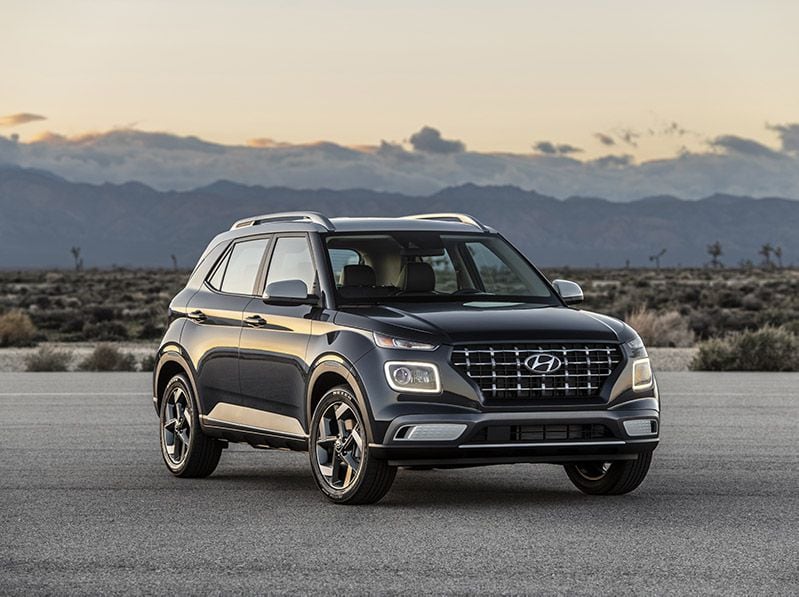
2020 Hyundai Venue ・ Photo by Hyundai
So far this year, 53 percent of Hyundai’s sales in the United States have been SUVs, and in the last two years, Hyundai has introduced three all-new SUV models. Well, here’s the fourth. It’s the 2020 Hyundai Venue. When it goes on sale this December, it will be the Korean automaker's smallest and least-expensive SUV and the sixth in its expansive lineup.
Built in Korea, the new Venue slots below the brand’s slightly larger Kona, which was introduced in 2018, and basically replaces the Accent hatchback. It’s a subcompact crossover and completes in a class rapidly growing in popularity as more and more buyers choose small SUVs over sedans and hatchbacks. Fun-to-drive and fuel-efficient, the Venue competes with many other small crossovers, including the Ford EcoSport, Nissan Kicks, Chevrolet Trax, Mazda CX-3, Honda HR-V, Toyota C-HR, and Fiat 500X.
Three Trim Levels to Choose From
Three trim levels are available on the 2020 Hyundai Venue: SE, SEL, and Denim. Each features front-wheel drive. Surprisingly, all-wheel drive is not available on the Venue as it is on the larger Hyundai Kona. Every Venue is also powered by a 1.6-liter four-cylinder engine it shares with Hyundai’s Accent sedan. Unlike the standard three-cylinder engine in Ford’s EcoSport, which is about the same size as the Venue, the Hyundai’s engine is not turbocharged. Yet, with 121 hp and 113 lb-ft of torque, it essentially matches the Ford’s output and performance.
Prices haven’t been set as of this writing, but the Venue should cost significantly less than the Kona, which starts right around $21,000, including a $950 destination charge, with front-wheel drive. We also expect it to undercut the price of the Ford EcoSport, which also starts right around $21,000. Our Denim test vehicle sits at the top of the Venue lineup and comes standard with every available option, including 17-inch wheels, LED headlights and taillights, heated front seats, navigation, and a sunroof.
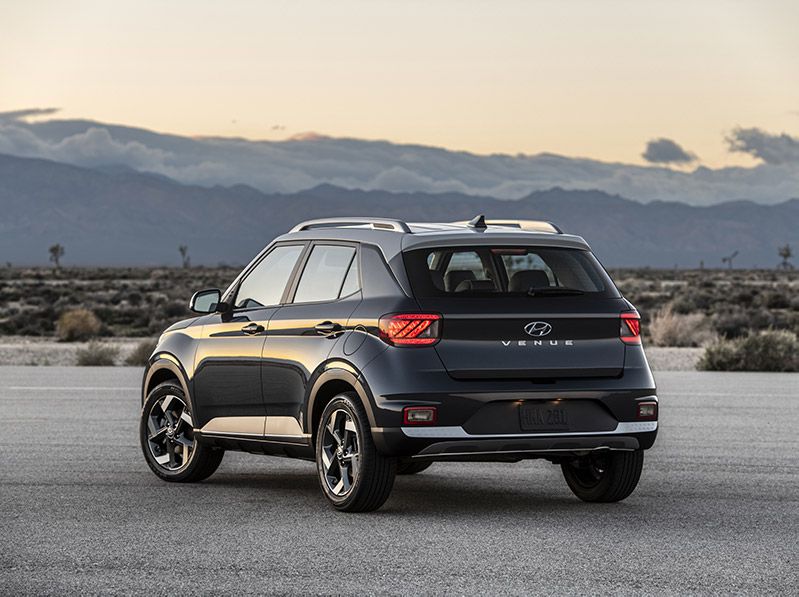
Photo by Hyundai
Attractive and Sporty Styling
To shape the exterior of the 2020 Hyundai Venue, its designers have successfully borrowed from the look of the seven-passenger Hyundai Palisade, the brand's largest SUV. This makes the Venue look larger than it is and gives it a more upscale look than others in its class. It isn’t as rugged-looking as the Kona, which wears an abundance of black plastic trim, but it's just as attractive and looks quite sporty thanks to shapely wheel well flares, a muscular stance, and chiseled character lines. Another cool design touch is the Venue’s contrasting white roof. It’s the only available option on the Denim model, which are all painted an attractive dark blue. The twist is that the white roof isn’t available with a sunroof.
With a 99.2-inch wheelbase, 159-inch overall length, and about 70-inch width, the Venue is smaller than the Kona, as well as most other subcompact SUVs, including the Kia Soul, Nissan Kicks, and Mazda CX-3. The Nissan Kicks, for instance, is the same width as the Venue, but it’s 10 inches longer and has a 4-inch-longer wheelbase.
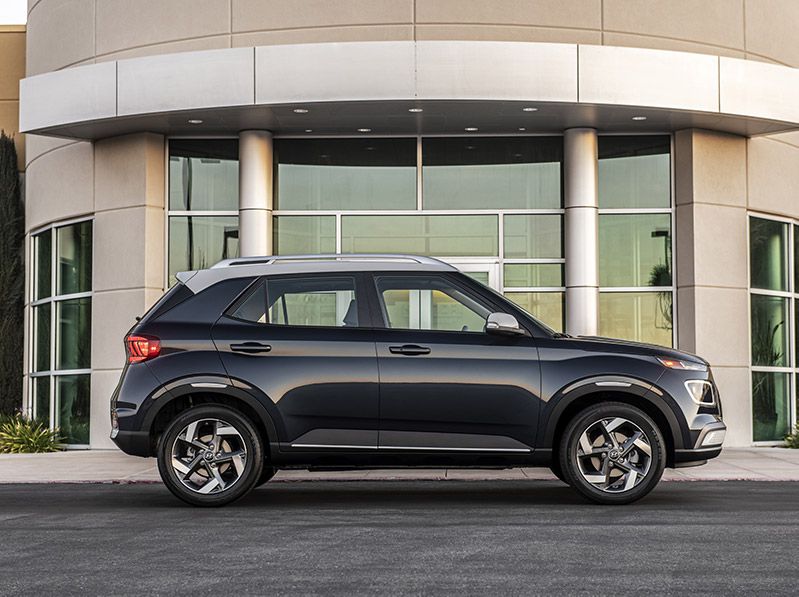
Photo by Hyundai
Comfortable and Spacious Interior
Although smaller than the Kona, Hyundai’s engineers have managed to give the Venue an impressive amount of interior space. In fact, it nearly matches the Kona’s interior dimensions, including its rear legroom. Like the Kona, the Venue seats four adults comfortably and can haul five if the ride is short. The cabin also feels spacious thanks to an abundance of glass and thin pillars, which also help visibility.
Its front seats are firm, supportive, and comfortable. The driver’s seat is also height-adjustable and a tilting and telescopic steering wheel is standard, so it’s easy to find your preferred driving position. Fit and finish are excellent, and all of the Venue’s controls are well-placed and function with a feeling of quality. Demin models even get a standard leather-wrapped steering wheel and shift knob. Our only issues with the Venue's interior are its rock-hard elbow rests on its doors and a headliner that feels like cardboard. It seems cheap, even for a car in this class.
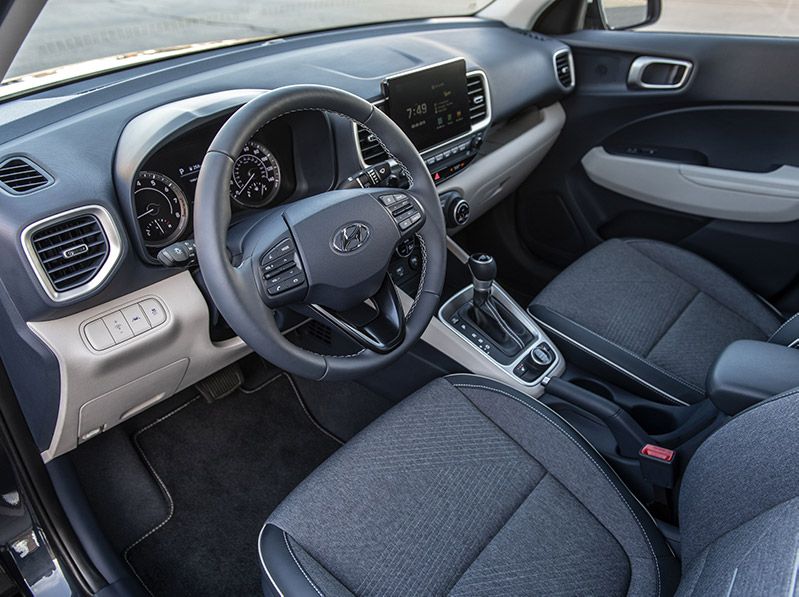
Photo by Hyundai
Solid Infotainment Tech
In the center on the Venue’s dashboard is an 8-inch infotainment touchscreen, which Hyundai says is the largest in this class. It looks a little tacked on, like it was glued to the dash as an afterthought, but it’s within easy reach and functions as it should. There are also large knobs for volume and tuning of the audio system and three more to control the air conditioning and heat. Our test car's navigation system also featured up-to-date graphics and simple inputs.
Bluetooth is standard, the system is compatible with Apple CarPlay or Android Auto, and Hyundai’s Blue Link system is optional on the SEL and standard on the Denim. Shortcomings are the lack of onboard Wi-Fi, which is not available, and the fact that a USB charging outlet isn’t standard on the SE and SEL models. It’s an option on the SEL.
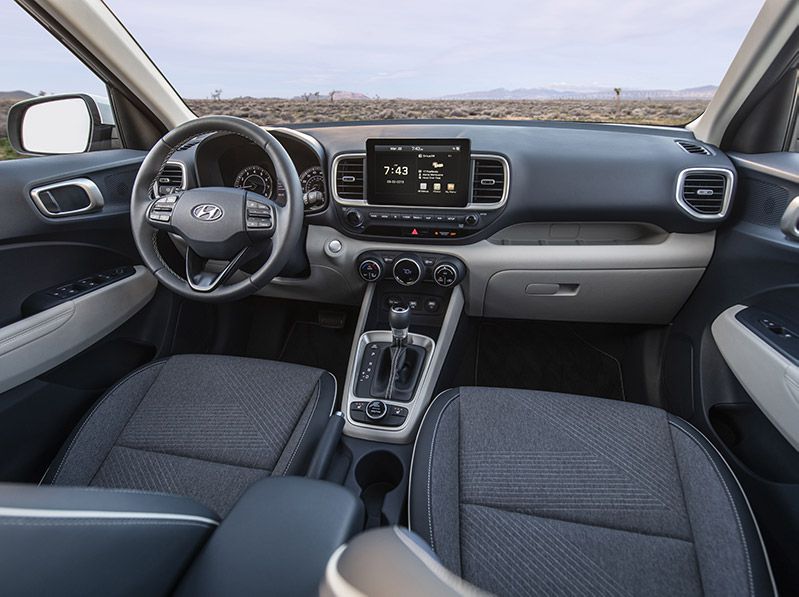
Photo by Hyundai
Advanced Safety Systems and Technology
All Venues come standard with advanced safety systems and technology, including a rearview camera, automatic emergency braking with pedestrian detection, a lane-keep assist system that helps steer the car to keep it between the lines, and a driver attention warning. Optional on the SEL model is blind-spot monitoring with a rear cross-traffic alert, which is standard on the Denim. Although standard cruise control is standard, radar cruise control, which automatically varies your speed based on the traffic in front of you, is surprisingly not available.
All of Hyundai’s other SUVs have been named a Top Safety Pick+ by the Insurance Institute for Highway Safety and they’ve been given a five-star overall crash test rating from the National Highway Traffic Safety Administration. Unfortunately, the Venue has not yet been tested by either institution.

Photo by Hyundai
Plenty of Cargo Space
There’s also plenty of storage space inside the new Venue. The console bin isn’t huge, but it’s deep and there’s another bin ahead of the shifter, which is a good place to throw your phone and wallet. Its door pockets are small, but they have slots for water bottles. The two front cupholders are large and well-placed behind the shifter.
The 2020 Hyundai Venue also offers a surprising amount of cargo volume. It offers 18.7 cubic feet of space behind its rear seat, which is good for this class and is essentially the same amount as you get in a Kona. Every Venue also comes standard with a 60/40 split-folding rear seat, which easily drops flat to expand that space to 31.9 cubic feet. There’s also a hard, high-quality cargo cover. A power liftgate isn’t offered, which is normal in this class.
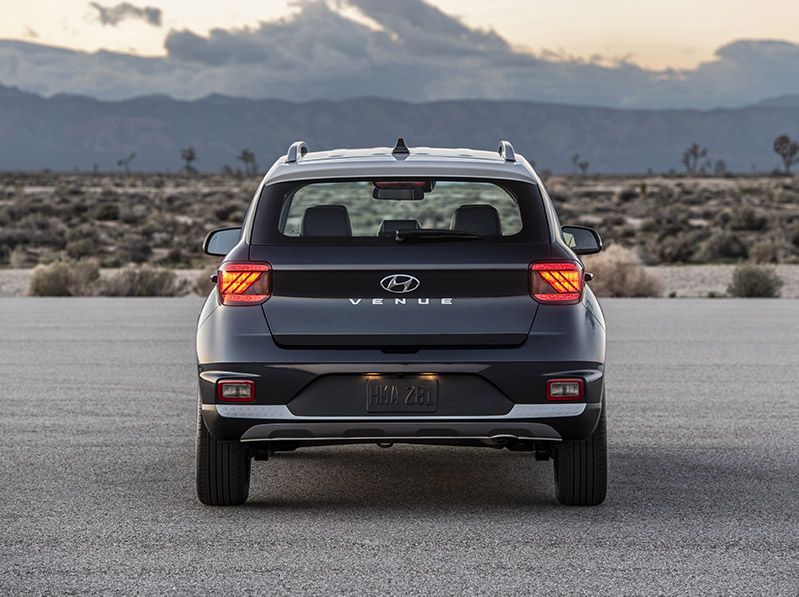
Photo by Hyundai
Good Acceleration and Handling
Since the Venue is small and only weighs about 2,700 lbs, its 121 horsepower is plenty, and the little SUV is quick enough for most buyers. Although its engine is a bit noisy above 4,000 rpm, the Venue is spunky off the line and has ample passing power on the highway. We also appreciated its handling, which features good balance, quick steering, and almost no body roll. It feels small and responsive on twisty two-lane, but also stable and solid on the highway. The SE and SEL get standard 15-inch wheels, while the Denim’s 17-inchers are optional on the SEL. Some may find the ride to be a bit firm with the larger wheels and tires, while others will like its sporty character.
Although most U.S.-spec Venues will have a continuously variable automatic transmission that Hyundai calls an IVT, a six-speed manual will be standard on the SE. Unfortunately, our test vehicle had neither. Instead, it included the conventional six-speed automatic used in other countries, like Australia. We’re told the IVT will have a manual mode so you’ll be able to choose your own gears. Choosing Sport mode increases the engine’s throttle response and recalibrates the transmission for quicker acceleration.
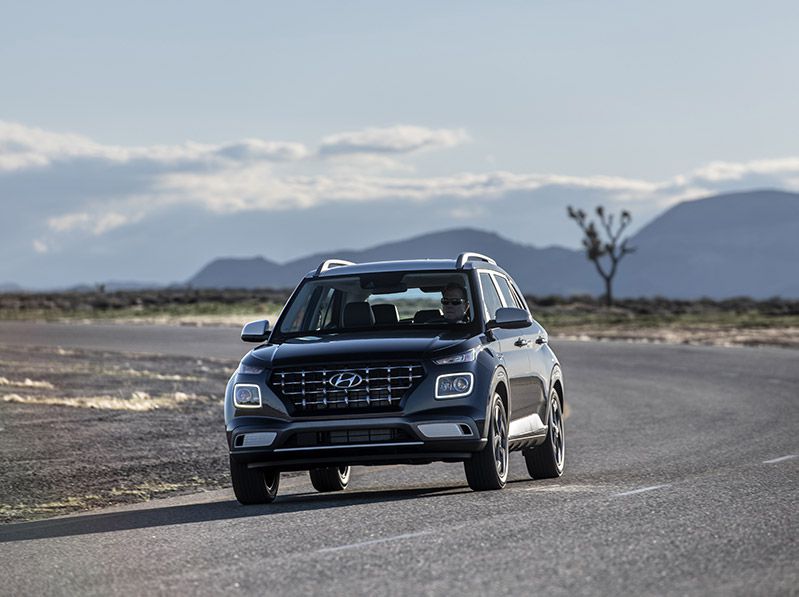
Photo by Hyundai
Impressive Fuel Economy
Hyundai says the Venue’s IVT may sacrifice some acceleration, but the tradeoff will be a radical increase in fuel economy. Although the EPA has not yet released its city and highway fuel economy ratings, Hyundai says the Venue is expected to deliver a combined fuel economy rating of 32 mpg. If true, it will be significantly better than the 28 mpg combined rating of the Ford EcoSport, and the 30 mpg rating of the front-wheel drive Kona. The Venue’s engine also runs on regular-grade gasoline to keep costs down.
While some hybrid crossovers get even better gas mileage, they don’t really exist in this class. The Kia Niro is more hatchback than SUV and costs about $24,000. The Toyota RAV4 Hybrid is considerably larger and starts at nearly $29,000.
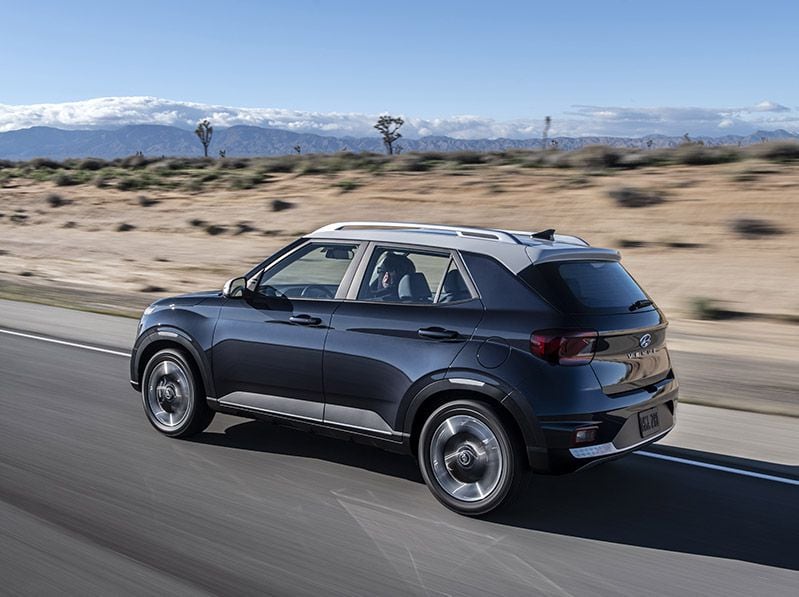
Photo by Hyundai
Final Thoughts
Hyundai has become a Master of the SUV, the King of the Crossover. Over the last five years, it has yet to make a bad one and its latest batch is a lovable bunch, each offering a compelling mix of design, engineering, and dynamics. Hyundai has the winning formula for SUV success, and it has recently given us the impressive Kona, the redesigned Santa Fe, and the Palisade, which is among the best large three-row SUVs.
Add the 2020 Hyundai Venue to that list of winners. Like the Kona, the Venue is comfortable, attractive, spacious, fun-to-drive, and economical. And like the Kona, it’s about to become a big-time seller in the subcompact SUV class.
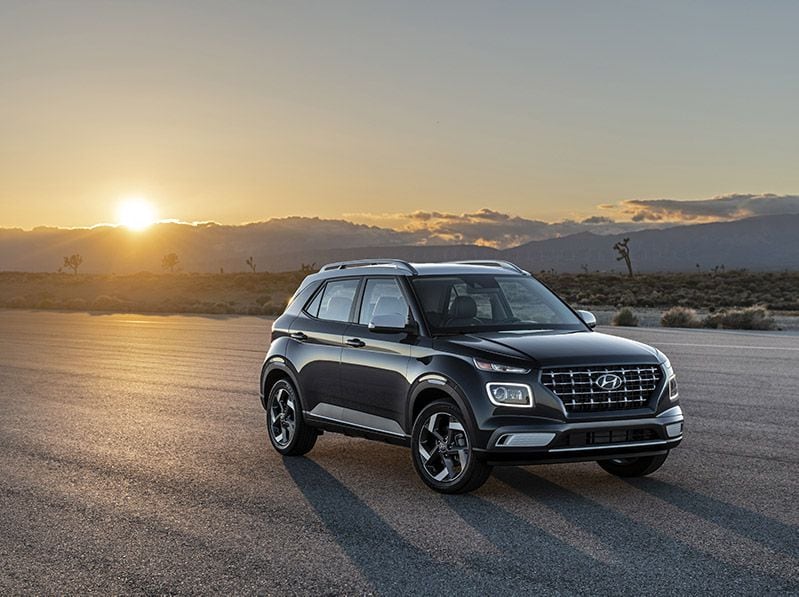
Photo by Hyundai